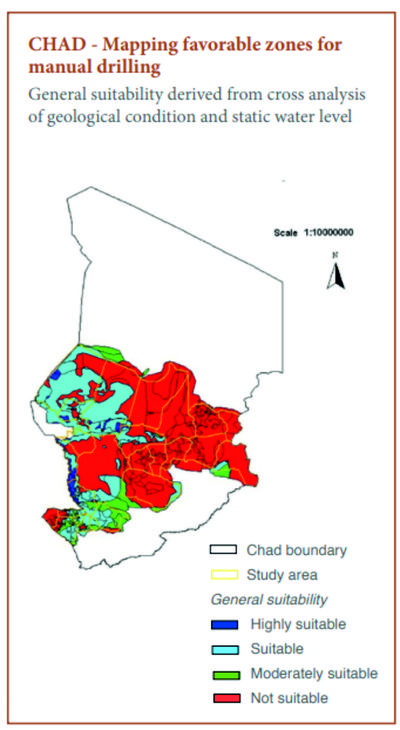Case Study Capacity Building Manual Drilling Chad
Africa Groundwater Atlas >> Additional resources >> Case studies >> Capacity building in the manual drilling sector in Chad
This page is being developed. Please check back soon for updates.
Go to the Hydrogeology of Chad page.
Capacity building in the manual drilling sector in Chad
How can manual drilling help improve water supplies?
Manual drilling is only appropriate in certain hydrogeological situations – e.g., where the rocks or sediments are easy to drill through and the water table is shallow. But in these areas, experienced, well equipped manual drillers can deliver boreholes much more cheaply and to the same standards as mechanical drilling, and often in areas that are hard to access by mechanical drilling rigs – so it is quicker and cheaper to increase people’s access to improved water supplies.
Water access and manual drilling in Chad
Access to improved water sources in Chad is poor – only 45% of the rural and 72% of the urban population. There have been manual drilling programmes in Chad since the 1960s, but most of the boreholes drilled failed after a few months, often because of unsuitable design and materials. This has led to negative perceptions of manual drilling in general.
However, today there are still many small and experienced private manual drilling enterprises in Chad, who in many areas produce good quality boreholes, but still encounter a number of problems. When this was recognised, the Government of Chad and a number of NGOs (including UNICEF and the PRACTICA Foundation) developed a strategy to support and build on the existing manual drilling sector, improving capacity and expanding the benefits of manual drilling more widely across the country.

Feasibility project by UNICEF and partners
In order to demonstrate the commercial viability of this approach, a feasibility project was started in 2006 to install 1000 new manually drilled water points to a suitable quality. The project was undertaken by UNICEF Chad with partners including the PRACTICA Foundation and the Government of Chad.
Choosing the right area for manual drilling
Initial work showed that the geology of large parts of central Chad appeared to be appropriate for manual drilling – rocks that are relatively easy to drill through, and a shallow water table. This is also the area where populations are rising fastest, and therefore where demand for new water supplies is growing.
 } Identifying and tackling problems with existing manual drilling techniquesThe project identified the main problems encountered with boreholes installed by the existing manual drilling sector as:
In response, the following actions were proposed to increase the professionalism and effectiveness of the manual drilling sector:
Training programmeAn intensive training programme for manual drillers was developed. A total of 43 existing manual drilling enterprises in Chad were selected to undergo training. Selection and training of 20 Quality Controllers was also done – largely staff of the Directorate of Hydraulic Affairs / Water Directorate. They received five days intensive coaching in the skills needed to assess and certify manually drilled boreholes. Training activities included a five day basic hydrogeological training course for the manual drillers, followed by a coached practical assignment to drill three community boreholes. These boreholes were assessed by the newly trained Quality Controllers. All the drillers then also received two days business management training from the Centre de Développment des Enterprises (CDE). Following the initial training, extra and/or refresher training was also offered as needed, including practical coached drilling sessions and further business management coaching. The final part of the training involved testing the drillers in their ability to drill and construct suitable quality boreholes and interact with community and social mobilizers. If successful, the drilling enterprises were awarded a Government-approved certification. Further capacity development initiativesHaving well-qualified drilling enterprises, standards and quality monitoring systems is not enough. The following aspects are also essential:
Project summaryThe development and implementation of a strategy to build capacity in the manual drilling sector takes time, flexibility and perseverance. Despite difficulties, the project described here has made substantial achievements. From 2006 to 2008, 13 of the 43 initially selected manual drilling enterprises went through the training programme; a group of 20 Quality Controllers were trained; and the Chadian Government officially endorsed the newly developed Technical Well Standards. The futureThe outlook for manual drilling in Chad is promising, with improvements seen in capacity and professionalisation of the sector. However, the capacity building programme described here cannot solve all the problems involved in developing sustainable water points – particularly in areas that are unsuitable for manual drilling. The ongoing development of new hydrogeological understanding arising from basic groundwater data collection and management can help by refining knowledge of where manual drilling techniques are appropriate, so that they can be targeted where they will be most successful. One area where manual drilling could have potential is in more remote areas such as the islands of Lake Chad. The sandy geological deposits there are suitable for manual drilling, and the transportation of heavy drilling machinery is harder, meaning that there is much scope for smaller manual drilling equipment. Professional maintenance in such remote areas is also more difficult, due to transport and capacity constraints, so there may be potential for supported community based management. There are also specific issues in this area that must be addressed: for example, high salinity groundwater, which can cause corrosion of borehole materials, may be a problem in this area. SourcesThis case study is based on the following report: Practica Foundation, UNICEF and EnterpriseWorks/VITA. 2009. The impact of manual drilling for the construction of sustainable water-points in Chad. For more on manual drilling in Chad and more widely in Africa, see also: Danert, K. 2014. Chad’s Growing Manual Drilling Industry. Skat Foundation, Switzerland. UNICEF, EnterpriseWorks/VITA and Practica Foundation. 2010. Professionalizing the Manual Drilling Sector in Africa: a guide to building capacity to increase access to safe water in rural areas. UNICEF, New York. |